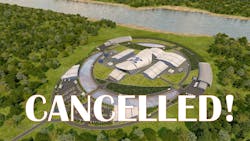Commercial SMR Prospects Dim On Cancellation of First Planned U.S. Site?
It seemed too good to be true. A consistent power cost of only $55/MWh for the operational life of a potential 462 MW nuclear power generation facility.
Supporters, including the DOE, who approved $1.35 billion in funding for SMR projects over the next decade starting with $232 million since 2020, had a very rosy view of the technology and its future.
But it seems that the view may have been through rose-colored glasses.
In a significant setback for the advanced nuclear industry, NuScale Power Corporation, the only U.S. developer with Nuclear Regulatory Commission (NRC) approval for a small modular reactor (SMR), last week announced the termination of the Carbon Free Power Project (CFPP).
The decision was reached in mutual agreement with the Utah Associated Municipal Power Systems (UAMPS), a group of local electric utilities that had originally agreed to purchase power from the project.
The CFPP was intended to be the country's first commercial small modular reactor, comprised of six 77-megawatt SMRs generating a total of 462 MW.
Located near Idaho Falls, Idaho, at the Department of Energy's Idaho National Laboratory, the project aimed to come online in 2029 with commercial power delivery starting the following year.
So What Does This Mean for NuScale?
Despite the disappointment surrounding the project's termination, NuScale remained committed to its vision. John Hopkins, NuScale's President and CEO, expressed confidence in the future of their SMR technology, stating, "Our work with CFPP over the past ten years has advanced NuScale technology to the stage of commercial deployment; reaching that milestone is a tremendous success which we will continue to build on with future customers."
It should be noted that NuScale's other announced projects, in PA, Ohio, and Ontario, Canada, have not been impacted, as yet, by this announcement.
Advocates of advanced nuclear technologies, such as SMRs, often focus on the argument that they offer a cost-effective solution for carbon-free energy generation that can operate nearly 24/7. However, with the project costs for the CFPP escalating to $89 per megawatt-hour, utilities that were needed to sign on to the project to make it commercially viable lost interest.
"This decision is very disappointing given the years of pioneering hard work put into the CFPP by UAMPS, CFPP LLC, NuScale, U.S. Department of Energy, and the UAMPS member communities that took the leadership role to launch the CFPP," said UAMPS CEO Mason, while recognizing that it was the best course for the coalition of local power providers he led. These providers still needed the electricity the project was initially set to supply, but right now the focus has shifted to winding down the project while exploring alternative energy sources.
UAMPS spokesperson Jessica Stewart has been quoted as saying that the group still has “ample time and opportunity to replace the energy output it planned to receive from the CFPP.” UAMPS’s efforts include looking at expanding a wind farm in Bonneville County, Idaho, as well as adding utility-scale solar and considering natural gas technologies that use hydrogen.
Too Slow and Too Expensive?
While various energy industry spokespeople have expressed disappointment in the cancellation of the project, there has been little comment on the elephant in the room.
While multiple issues led to the cancellation of the project, the most noticeable is one that has plagued the nuclear power industry; spiraling costs between the planning stage and the actual commissioning of a facility and delivery of power.
It’s hard to ignore the fact that the first new nuclear power plant in the US in seven years, Georgia Power’s Vogtle site, which came online a few months ago, came in years late and more than 100% over it’s original $14 billion budget.
With one of the messages of the SMR proponents being on-time, lower-cost delivery of new generation sites, this project cancellation may make people worry that SMRs are just a new verse in the same old song.
About the Author



